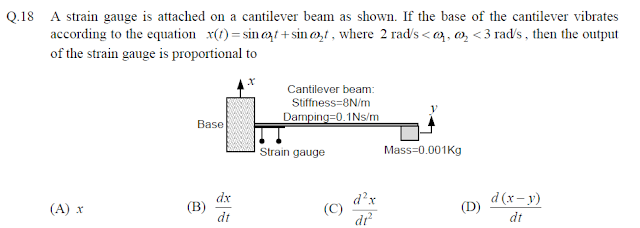Capacitive sensors are
based on changes in capacitance in response to physical movement. These sensors
find their applications mainly in humidity, moisture and displacement sensing.
Reactance of a
capacitance C is given by 1/(jωC),
since i = C (dv/dt). These sensors have high
impedance at low frequencies, as clear from the reactance expression for a
capacitor. Also, capacitive sensors are non-contacting devices in the common
usage. They require specific signal-conditioning hardware. In addition to
analog capacitive sensors, digital (pulse-generating) capacitive transducers
such as digital tachometers are also available.
A
capacitor is formed by two plates, which can store an electric charge. The
stored charge generates a potential difference between the plates. The
capacitance C of a two-plate capacitor is given by
A is the common /overlapping area of the two plates; m2
d
is
the gap width between the two plates; mε is the dielectric constant or permittivity, ε = εrεo; F/m
εr is the relative permittivity,
εo is the permittivity of vacuum; 8.85x10-12 F/m.
The
capacitive transducer work on the principle of change of capacitance which may
be caused by:
(i)
Change in overlapping area A,
(ii)
Change in the distance d between the
plates, and
(iii)
Change in dielectric constant
The cause of these
changes can be displacement, force and pressure. We will discuss the various
types below:
A.
Transducers
based on Change in overlapping area
x = length of overlapping plates; m
For
a cylindrical capacitor, the capacitance is given by-
x = length of overlapping part of cylinders; m
x = length of overlapping part of cylinders; m
D2 = inner
diameter of outer cylindrical electrode; m
D1 = outer
diameter of inner cylindrical electrode; m
Capacitive transducers can be employed
to measure angular displacement also. If we have two plates- one fixed and one
rotating, then their overlapping are is a function of angle between the
overlapping edges.
The maximum capacitance is when the two plates
completely overlap each other.
If the angle of overlap area is θ
A. Transducers based on Change in
distance between plates
The capacitance between plates is inversely
proportional to the distance between them.
The
relationship between capacitance C and distance between the plates d is
hyperbolic.
The sensitivity increases as x decreases.
The
percent change in C is proportional to the percent change in x.
A.
Transducers
based on change in Dielectric constant
Measurement of displacement
Normal capacitance when
dielectric medium is partially overlapped with metal plates-
If the dielectric
material is moved a distance ‘x’ in direction as shown, the capacitance changes
by ‘∆C’.
Measurement of Liquid Level
This type of transducer is predominantly used in the form of
two concentric cylinders for measuring the level of fluids in tanks. A non-conducting
fluid forms the dielectric material. The method is generally based on the
difference between the dielectric constant of the liquid and that of the gas or
air above it. Two concentric metal cylinders are used for capacitance as shown
in Figure below.
Capacitive Differential Transducer
A normal parallel plate capacitive transducer exhibits
non-linear response. By using differential arrangement, we can get linear
response for capacitive differential transducers. The arrangement is shown
below:
It consists of two fixed plates and one moving plate whose
displacement is to be measured. It acts like two capacitors in series.
Let C1 and C2 be the capacitance of
individual parallel plate combination when the movable plate is at middle
position. Thus,
For a voltage ‘V’ applied across the fixed plates, the
voltage appearing across individual plate combination is equal when the movable
plat is at middle position.
Differential voltage ∆V= 0.
Let the movable plate is moved by a ‘x’. Therefore the new
values of C1 and C2 are given as-
This method can have accuracy upto 0.1% and measurement
range can be from tens of nm to 10 mm.
Charge Amplifier
Circuit
An op-amp circuit with
a feedback capacitor Cf, which is similar to a charge amplifier, may be used
with a variable-capacitance transducer. A circuit of this type is shown in
Figure below. The transducer capacitance is denoted by Cs. The charge
balance at node A gives VrefCs + VoCf = 0. The circuit output is
given by


















































